Making a Down Payment on New York City’s Future
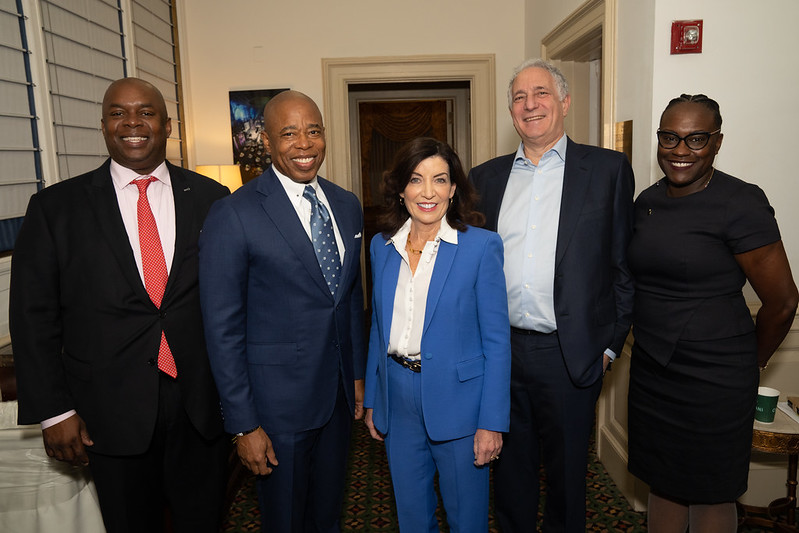
The co-authors: Richard Buery, left, & Dan Doctoroff, second from right (photo: Governor's Office)
In 2022, we co-chaired an extraordinary group of New Yorkers tasked by Governor Hochul and Mayor Adams to rethink the city’s commercial districts. When the plan was announced in December, the once-in-a-generation alignment between our political leaders was on full display as they affirmed 40 specific initiatives in an action plan and policy agenda called Making New York Work for Everyone that rises to meet this moment of evolution of our city.
This plan both recognizes the importance of our business districts as the fiscal foundation of our entire downstate region and also acknowledges that solutions must address a wider range of interconnected challenges affecting all New Yorkers.
And while some plans just sit on a shelf, this one is not. The goals, strategies, and initiatives may be bold, but already we are seeing the Governor and the Mayor make down-payments on the plan in their policy agendas for 2023, in financial commitments to initial projects, and in subsequent announcements of these initiatives.
Here are a few we are most excited about:
Reimagining New York’s Business Districts as 24/7 Destinations
The ‘New’ New York panel recommended repurposing vacant office space in our business districts and fill them with a variety of uses that drive foot traffic and vibrancy in our core. In January, Mayor Adams released the Office Adaptive Reuse Task Force’s 11 detailed recommendations for regulatory and legislative changes to facilitate the conversion of underused office space into new housing for New Yorkers. Governor Hochul made a down-payment on these necessary changes by proposing in her 2023 State of the State policy agenda and Executive Budget changes to make more buildings eligible to convert from commercial to residential as well as a new property tax exemption in New York City that would incentivize putting affordable housing in those converted buildings.
And as a first step towards creating a network of world class public space in Midtown, in December Mayor Adams announced a major new visioning process to reimagine 5th Avenue from Bryant Park to Central Park to prioritize pedestrians, cyclists, transit, and public realm. Furthermore, in Mayor Adams’ State of the City, he outlined an over $375 million investment toward permanent public spaces citywide—new plazas, widened sidewalks, and inviting landscaping in core business districts plus a new permanent Open Street in all five boroughs. And to spearhead this investment, City Hall recently announced the appointment of a new Chief Public Realm Officer, a key recommendation from the ‘New’ New York plan.
Making It Easier for New Yorkers to Get to Work
In her State of the State address, Governor Hochul prioritized transportation, furthering through her 2023 agenda key initiatives from the ‘New’ New York plan—securing the MTA’s future, making the MTA’s “City Ticket” available 24/7, continuing progress towards implementing congestion pricing, and improving bus reliability.
Generating Inclusive, Future-Focused Growth
Building on the strategies from ‘New’ New York plan, Governor Hochul has made tackling the housing crisis a key pillar of her policy agenda this year, and her State of the State and Executive Budget highlight key regulatory and legislative changes that are needed to reduce barriers to housing growth in New York City and statewide. They include transit-oriented development so more people can live in walkable, mixed-use communities with good access to jobs; making it easier to move through the process to get approvals for housing developments that align with these goals; allowing New York City to locally determine appropriate maximum residential densities; and updated tax exemptions for preserving affordable housing; among others.
Mayor Adams echoed these themes in his State of the City, with housing a key pillar of his agenda. He has called out the need to address New York City’s housing shortage in no uncertain terms. In addition to reaffirming his commitment to creating a “City of Yes,” the Mayor announced new planning and engagement efforts for needed housing to Midtown Manhattan and the North Shore of Staten Island. The Mayor also recently announced the launch of the Small Business Opportunity Fund to support a more inclusive and diverse economy.
We need to grow, but we need to do it in a way that allows all New Yorkers to participate in and benefit from that growth. In her State of the State and Executive Budget, Governor Hochul announced key initiatives to reduce barriers to labor force participation—making childcare more affordable and accessible; expanding the Medicaid Buy-in Program for New Yorkers with Disabilities; and streamlining the Minority and Women Business Enterprise (MWBE) certification process by pursuing reciprocity with New York City’s own certification system.
We are encouraged to see these immediate actions by the Governor and the Mayor to advance initiatives out of Making New York Work for Everyone – but we need to make sure we are following through with the upcoming state and city budgets. And we need to ensure that we are advancing strategies for truly inclusive and equitable growth — for example by investing in state and city programs to stabilize housing for vulnerable New Yorkers and ensuring that all New Yorkers can earn a living wage, especially in the face of sustained inflation. This is a multi-year plan, and these early items create the momentum and excitement we need to jump start implementation.
In all our years in government, we have never seen stronger alignment between the Mayor and Governor—an alignment of policy agendas that can help catalyze meaningful change to truly make New York work for everyone.
***
Richard Buery and Dan Doctoroff were co-chairs of the ‘New’ New York panel formed by Governor Hochul and Mayor Adams. On Twitter @RichardBuery & @DanDoctoroff.
***
Have an op-ed idea or submission for Gotham Gazette? Email This email address is being protected from spambots. You need JavaScript enabled to view it.
To Reach More Disconnected Young Adults, Partner with Their High Schools
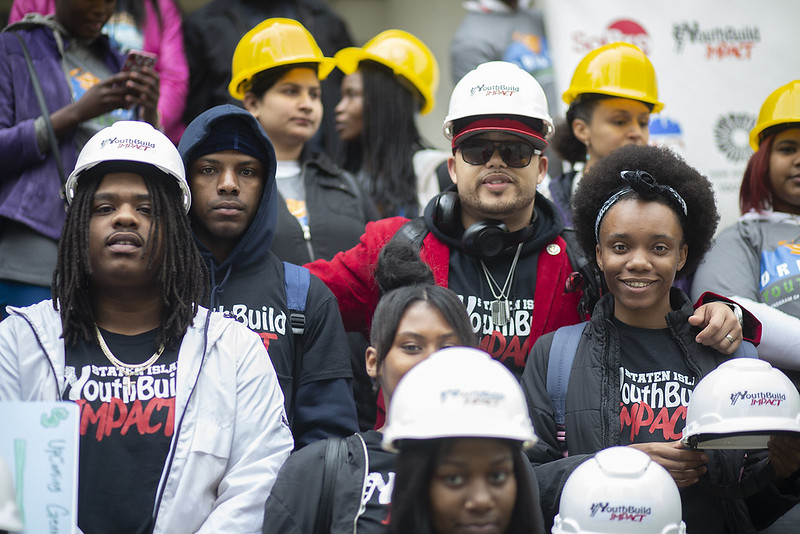
Youth employment programs at work (photo: William Alatriste/City Council)
A 2021 report by the city warned that up to 25% of New Yorkers aged 18-24 were at risk of becoming “disconnected,” meaning neither working nor attending school. And indeed, nearly 18% of young New Yorkers are unemployed, with rates for young men and women of color even higher. So it was alarming to read reporting from Gotham Gazette last week that the city’s programs to combat youth unemployment are under-enrolled and unable to expand to meet the need.
But even as elected officials, service providers, and workforce development experts grappled with this seeming disconnect, they neglected one resource that could play a significant role in solving this problem: high schools.
We have seen this problem up close. By most traditional metrics, MESA Charter High School, which we co-founded, has been a success. A non-selective school where students are admitted by lottery and over 85% are classified as “low-income,” MESA graduates 93% of its students on time, far outpacing the city average. Yet too often, our alumni struggle after graduation.
Despite meeting “college readiness” benchmarks, our students still graduate onto a razor’s edge. The slightest setback — a cut in a parent’s wages that impacts their ability to pay for college, a bureaucratic slip-up at a university, a missed payment deadline — can lead to disaster. Students drop out and wind up either unemployed or in low-wage, dead-end jobs.
So two years ago we honed in on supporting our “disconnected” alumni, either by helping them re-enroll in college or matriculate into a free, non-profit workforce program that led to a high-quality job. This year, we formally launched our Alumni Lab, a six-week bootcamp that works with alumni on a variety of topics, some as broad as developing a growth mindset and financial literacy to others as specific as resume writing and interview coaching. We’ve had 30 alumni go through the program thus far, and 70% have either returned to college or matriculated to a high-quality workforce development program in fields such as tech, medical professions, building trades, culinary arts, or business and entrepreneurship.
As Adams administration officials told the City Council last week about their own programs, the greatest challenge is getting young people to join ours in the first place. Students have been taught that success means seamlessly moving from high school to college to career; popular culture and social media often reinforce that narrative. When a student falls off track–as many do–they feel a sense of failure and shame. Many of our alumni have described feeling embarrassed that they had “let down” their parents, their teachers, and themselves.
The key to overcoming that shame? The relationship with their high school.
We’ve known these young people and their families for years, in some cases for a decade. Almost to an individual, they will describe the positive, supportive environment they experienced while at MESA. Accepting support like the kinds being offered by workforce development programs also requires vulnerability, an acknowledgement that one has fallen off track somewhere along the line. Understandably, young people are much more likely to open themselves up this way to an institution that they have years of trust with than to a bunch of strangers.
The best way for city workforce programs to fill their seats would be to partner with high schools.
“Disconnected Youth” are, by definition, hard to reach. But 75% of them have a high school diploma, which means they have a relationship with at least one institution. Additional funding to high schools to support their alumni after graduation could create a smooth pathway from high school to post-secondary programs, as well as a stronger safety net when students struggle after graduation. Because of the pre-existing relationships between schools, students, and families, the school is also better situated to provide the follow-up and continued support that everyone agrees students need to be successful.
Bringing high schools into the fold makes economic sense, too. Thanks to some generous philanthropic contributions, we’ve been able to run our program on just over $2,000 per student. Next year we hope to expand the number of kids served and partner with a few other high schools, which will bring the cost below $1,400 per child.
According to the 2021 New York City report, the fiscal burden on taxpayers of each disconnected youth is $16,000 annually. Given the city’s estimate of over 100,000 disconnected youth, investment in a partnership with high schools could yield hundreds of millions in savings.
While the news that program slots are going unfilled is disheartening, the good news is that there are high-quality programs out there ready to work with young people who are teeming with potential. The city faces several deep, intractable problems, but this one is fixable. Partner more with high schools, and watch the programs fill up.
***
Pagee Cheung and Arthur Samuels are the Co-Founders & Co-Executive Directors of MESA Charter High School in Brooklyn.
***
Have an op-ed idea or submission for Gotham Gazette? Email This email address is being protected from spambots. You need JavaScript enabled to view it.
The New Public Campaign Finance Program Gives More Influence to Everyday New Yorkers and Less to Wealthy People Like Me — That’s Great, Let’s Make It Happen
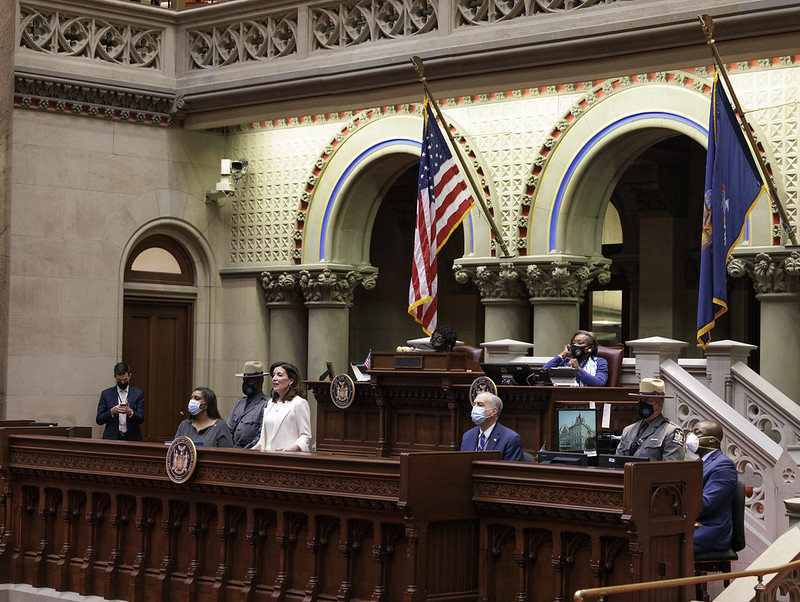
Gov. Hochul and other state leaders (photo: Mike Groll/Governor's Office)
This November, New York launched a new public campaign finance program for statewide and state legislative candidates. By providing candidates with generous matching funds, the program aims to increase the influence of everyday New Yorkers in Albany.
I have put a lot of money into politics over the years — and I think that this program is a great idea. I want every New Yorker to enjoy the same level of access and influence that I have, and I want elected officials to be accountable to everyone, not just rich people like me and my friends. The program will take monumental steps in doing just that.
In last year’s New York elections, the 200 largest individual donors contributed $15.9 million to candidates, which was about $2 million more than all 206,000 small donors combined. In the federal midterm elections for the U.S. Congress, just 21 of the biggest donor families spent a total of $783 million, which was more than the combined contributions of 3.7 million small donors. Small donors have certainly increased their giving in recent years, but unfortunately, big donors like me have completely and utterly swamped them, especially after the 2010 Citizens United ruling opened the floodgates to independent spending by Super PACs.
The result of the dominance by big money in campaigns is a political system where elected officials are more responsive to the interests and preferences of the rich and special interests. While I benefit personally from this, it’s not what I want in a democracy. Wealthy people definitely vote more often and volunteer more on campaigns, but, at the end of the day, it’s our money that makes the difference to candidates and elected officials.
With its new initiative, New York has taken a significant step in the right direction in fixing this mess. Eligible candidates can voluntarily opt into the program to receive matching funds on small, private donations (up to $250) that they receive from their would-be future constituents. For example, for statewide elections like Governor and Lieutenant Governor, candidates can receive $6 in matching funds for every $1 they receive from small-donor New York residents.
The program will not stop wealthy people like me and my friends from spending big in elections, but it will certainly make our spending less important to our representatives. 11% of contributions to New York legislative candidates in the 2022 cycle came from small donors of $250 or less. By one estimate, under the new program, that figure could increase to as much as 67%.
The initiative will also incentivize candidates to spend their time fundraising among more of the people that they seek to represent. I don’t want candidates to spend their evenings at swanky law firms rubbing elbows with a smattering of wealthy people like me and my friends – especially if we won’t even be their constituents! Instead, I want candidates to spend their time among everyday New Yorkers, listening and learning about what action really needs to be taken in Albany to improve lives.
Lastly, the program will also break barriers to entry for diverse political candidates like women and people of color, who may not have friends or brothers-in-law who are rich real estate developers or Wall Street financiers. Launching successful campaigns for office is extremely expensive in America, which effectively means that candidates cannot launch viable campaigns without the backing and approval of affluent donors like me.
The new public financing program breaks this cycle and will bring a new set of demographically diverse candidates onto the scene, all of whom will bring a different, unique perspective to Albany with regard to the problems that everyday New Yorkers are facing today. We’ll likely see the same results across the state that we saw in New York City: thanks to the expansion of its own municipal public campaign financing program, in 2021, the city elected its most demographically representative City Council to date.
The program has officially launched, but that doesn’t mean the fight for political equality in New York is over. There are now reports that lawmakers may vote to delay payouts for the program for another two years, despite the fact that over a dozen candidates have already signed up to participate. Moreover, in her 2024 executive budget, Governor Hochul included $39.5 million for the initiative; while generous, it’s not enough to give the program the wings it needs to deliver on its promise.
In their ongoing budget negotiations, legislators need to take action. According to a newly-released poll, 62% of voters across the Empire State support the new campaign finance program and want to see it fully funded. Lawmakers must do it - without delay.
I am a wealthy New Yorker who wants my voice to be heard, but not any more so than anyone else in the state. I want this program to succeed because I want to get big money out of politics — especially my money. Now it’s up to officials in Albany to make it a reality.
***
Morris Pearl is a former managing director of BlackRock and is the Chair of the Patriotic Millionaires. This piece was written in conjunction with the Brennan Center for Justice at New York University School of Law. On Twitter @morris_pearl, @PatrioticMills, & @BrennanCenter.
***
Have an op-ed idea or submission for Gotham Gazette? Email This email address is being protected from spambots. You need JavaScript enabled to view it.
Help Needed for Those Helping Newcomers to New York City
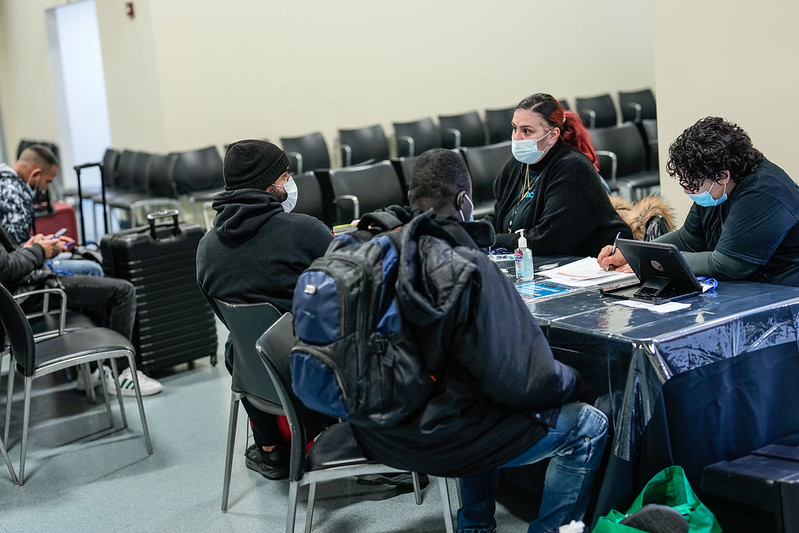
Serving asylum-seekers (photo: Michael Appleton/Mayoral Photography Office)
Recently, Mayor Eric Adams traveled to El Paso, Texas to shine a bright light on the burgeoning border crisis ramifications facing New York and other cities. He followed up that visit with a plea for help at a meeting of the American Conference of Mayors in Washington, D.C.
When tens of thousands of asylum-seekers, refugees, and other migrants arrived in New York with little more than the clothes on their backs, the immediate focus was on providing temporary housing. In that regard, the city has opened more than 70 emergency shelters and four ‘humanitarian relief centers.’ Without much notice, nonprofit organizations have stepped in since the beginning of this crisis to provide not only a roof over their heads, but a broader range of critical services to support the long-term stability of those who are starting over in New York City.
These organizations have been working with city agencies and putting all their strained resources on the line to help support more than 40,000 newcomers who have arrived in New York since last spring. The city projects up to $4 billion in ultimate costs for these services over two years, and as a result is planning budget cuts in other essential areas. City shelters are filled to capacity and beyond, and Mayor Adams has declared a state of emergency.
The federal government has to date approved $800 million in grants for states, local governments, and nongovernmental organizations dealing with the increase in migrants and thankfully much of it is reportedly expected to flow to New York City. Mayor Adams has also submitted an emergency aid request to New York State for immediate help to shelter arriving newcomers and Governor Hochul has proposed funding in her budget plan.
We are grateful that Washington is beginning to realize that New York City should not have to foot this bill alone. The federal government and the state of New York must do more to help.
Many recent refugees risked their lives to escape economic hardship and political turmoil in Venezuela and elsewhere, hoping to find safety and a better life for their families. Some are now seeking asylum. After the trauma and life changes they endured, they have many needs beyond just housing – food, health care, legal paperwork, English language education, employment opportunities, and school for their children. To achieve lasting stability, they need support in all these ways, and more.
BronxWorks, the organization I head, is one of the many nonprofits helping to support migrants. As a settlement house, this work is in our DNA. Settlement houses were founded to support newly-arriving immigrants to adjust to life in the city. Since the beginning of this crisis, we have provided support to needy migrant families, and this past September, we rapidly set up a family sanctuary shelter to meet their specific needs. More than a dozen BronxWorks staffers worked around the clock, many on their own time over a weekend, to get our family sanctuary up and running. Within weeks, we housed 300 individuals, including 110 children, in studios with a kitchenette and shared laundry facilities.
We’ve welcomed families like Roberto, Claudia, and their five-year-old daughter, who fled persecution in Venezuela to pursue a safer life here in the United States. Our shelter now serves 90 families.
BronxWorks staff have not let up, working hard to ensure all the needs of these families are met. We connect our newest neighbors to resources for food and health care, employment, and other services. We have helped them secure NYC-IDs so they have a form of identification, as well as access to enriching cultural and arts opportunities in their new home. As families are settling in, they are learning English, enrolling their children in school, and forming community connections.
This is what many nonprofits in New York City do. As the leader of a nonprofit in the Bronx and a board member of the Human Services Council of New York, I’ve seen what organizations across the city are doing in the face of this true emergency. We have doubled down on our efforts, just as we did during the pandemic, because it is our mission, and despite the fact that we are already stretched thin.
The unsustainable influx of newcomers to New York City is a national problem and more funding as well other housing locations around the state and elsewhere must be identified, or this current system will be unable to effectively support these families as they make the transition into their new lives. New York City didn’t create this crisis and can’t bear the burden alone. Neither can the nonprofit community.
***
Eileen Torres is executive director of BronxWorks, a human service organization and settlement house based in the Bronx and founded in 1972. On Twitter @BronxWorks.
***
Have an op-ed idea or submission for Gotham Gazette? Email This email address is being protected from spambots. You need JavaScript enabled to view it.
The Mayor Must Finally Improve City Government Before Valued Nonprofit Service Providers are Lost
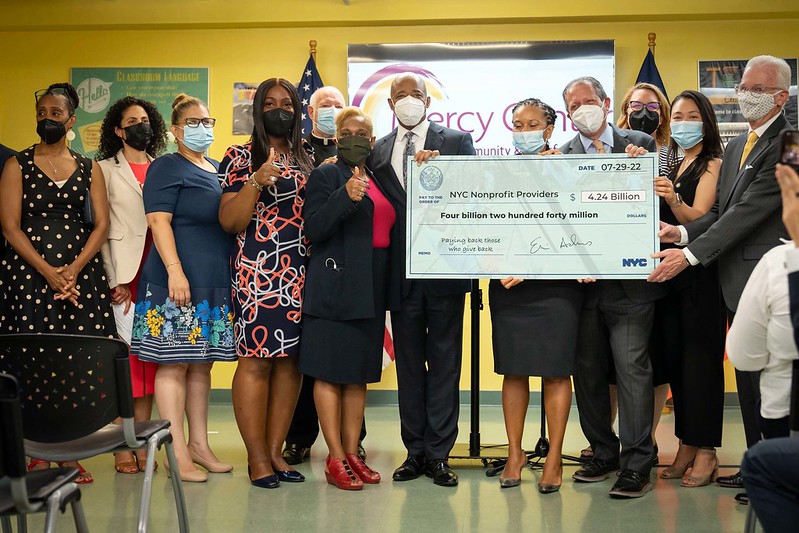
Payments to nonprofit providers (photo: Ed Reed/Mayoral Photography Office)
Nonprofits that provide essential city services are in crisis. New York City government’s failure to pay nonprofits on time for the vital work they are doing for the city is jeopardizing the existence of these critical organizations that New Yorkers – especially the poorest and most vulnerable – rely upon.
In the past two weeks there has been reporting that two venerable nonprofits — GEMS and Sheltering Arms -- are in danger of closing because of delayed city payments. This is devastating news for New Yorkers.
Before GEMS’ founding, children as young as 11 years old – overwhelmingly low-income girls of color – who were the victims of repeated rapes as part of the commercial sex industry were sometimes being arrested and charged with prostitution. GEMS fights to empower girls and women ages 12 to 24 who have survived commercial sexual exploitation and trafficking to escape these circumstances and reach their full potential.
Sheltering Arms Children and Family Services operates much-needed youth homeless shelters, foster care, mental health treatment, and housing and educational programs throughout New York City.
Unfortunately, the fate of these two organizations is emblematic of a larger trend caused by the city’s failure to timely pay nonprofits that provide essential services on behalf of the city. A 2021 report by the city’s Human Services Recovery Task Force found that more than 1,800 nonprofits were in danger of closing, with revenues down an average of $9.1 million.
Much of this is a direct result of the city’s failure to pay contracts in a timely manner.
Before a contract can be paid, it must be registered. And the City does not do a good job of registering contracts in a timely manner. According to the City Comptroller’s office, in Fiscal Year 2021, for over 16% of all contracts it took the city over a year from start date to presentation to the Comptroller for registration. Another 27% took at least half a year. The numbers are even worse for human services contracts, where over 21% take more than a year and an additional 30.5% take more than half a year.
Not only does failure to register prevent payment, but registration is also important because it affects the rights of the nonprofit against city government. Without registration, there is no enforceable contract and so no right to sue for breach of contract if payments are never made or unreasonably late.
The problem of delayed payments is on the radar of both Mayor Adams and Comptroller Lander. Even before taking office, they created, in December 2021, a Joint Task Force to Get Nonprofits Paid on Time. In February 2022, the Joint Task Force released 19 recommendations. One recommendation was to put time limits on the various steps needed to approve contracts. Unfortunately, while these proposals came out a full year ago, many have not been implemented, including that timing one.
There may be some help on the way. There is a bill in the City Council (Intro. 511) now in committee that would legislate time limits on agencies for processing contracts. Specifically, the bill would require the Procurement Policy Board (“PPB”) to establish (1) The time limits within which the contracting agency must complete each step of the procurement process; and (2) The time limits within which each mayoral agency charged with oversight of the contracting agency must complete its oversight review of the procurement contract.
While this legislation is a helpful start, without some changes it may not have sufficient impact. To begin with, the legislation does not have hard deadlines for the PPB to do its work -- the Task Force to Get Nonprofits Paid on Time called for these same deadlines over a year ago and nothing has happened yet. Also, the bill sets no penalties if the newly-created deadlines are missed. As a result, the deadlines, even once they are set, will be difficult if not impossible to enforce.
With or without legislation, any real change will require mayoral buy-in.
We served for years as Commissioner (Peters) and First Deputy Commissioner (Brovner) of the city's Department of Investigation (DOI). It gave us a deep understanding of the inner functioning of the agencies now contracting with nonprofits to provide services, and one thing is clear: Without an increase in both staffing and technology infrastructure, it is extremely unlikely that these city agencies will meet deadlines no matter what strictures are imposed.
There are devastating consequences to good nonprofits going out of business. Not only do vulnerable New Yorkers lose the services that they are entitled to, but dysfunctional and sometimes corrupt nonprofits move in to take the place of the good ones that went under. We saw this over and over again both while prosecuting charities fraud at the New York State Attorney General’s Office and again at DOI while serving as the Inspector General for city agencies that repeatedly entered into contracts with questionable nonprofits when they couldn’t find anyone else willing to contract with the city.
We've seen the problem of delayed city payments up close as private attorneys as well. We have represented several entities that provide vital services on behalf of the city and have seen delays -- often of years -- in getting the city to pay for these services. This can pose a real threat to the providers' ability to stay in business and can lead to the untenable choice of taking out expensive loans or simply getting out of the business of serving the city and its residents.
New York City needs to start paying its bills on time, and it needs to do that now, before more essential nonprofits go under and vulnerable New Yorkers suffer needlessly.
***
Lesley Brovner and Mark Peters are founding partners of Peters Brovner LLP, a boutique law firm in New York City.
***
Have an op-ed idea or submission for Gotham Gazette? Email This email address is being protected from spambots. You need JavaScript enabled to view it.
To Achieve Real Financial Accountability, New York City Needs a Public Bank
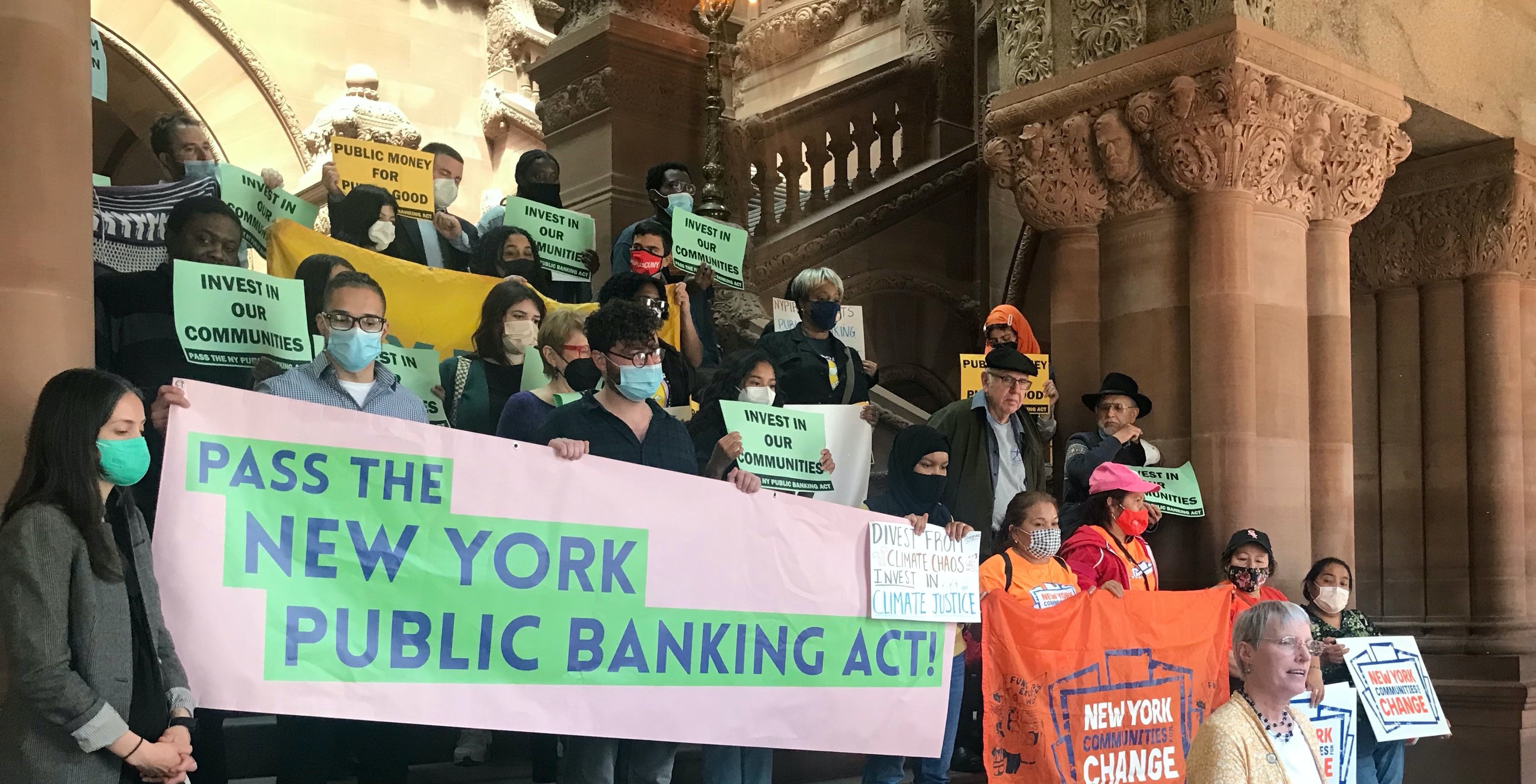
The push for public banking (photo: @PublicBankNYC)
Here’s something that might surprise you: Almost all of the $100 billion in revenue New York City will collect this year to pay for schools, buses, and other public services will be deposited in three big banks – JPMorgan Chase, Bank of America, and Citi. That’s because New York State requires local governments to put our public funds in banks, essentially handing Wall Street a lucrative monopoly that it has lobbied to uphold for more than a century.
Talk about easy money. We give big banks our public dollars, from which they profit handsomely, and New York City gets no meaningful commitments from them in return. It’s time to change the way the City does its banking and use our considerable leverage to ensure that public money works for the public good.
The City has begun taking steps in the right direction. New measures by Mayor Eric Adams and Comptroller Brad Lander aim to hold the City’s designated banks “more accountable to the public,” and will bring needed sunlight to the NYC Banking Commission. The Commission, a three-member body, composed of the Mayor, Comptroller, and Commissioner of Finance (a mayoral appointee), is charged with designating which banks are eligible to hold City deposits.
Now, when banks apply for designation, the Commission will require that they submit detailed plans to prevent lending and employment discrimination in their operations. The Commission also will, for the first time, open up the designation process to public comment and testimony.
The City’s recent decision to cut ties with Wells Fargo helped spur the Commission to revamp its designation process, according to Comptroller Lander. In fact, New York City’s bumpy relationship with the scandal-ridden bank is a case in point of how compromised we are when we entrust our public money to Wall Street.
In 2017, environmental and indigenous rights activists called on the city to ditch Wells Fargo amid nationwide protests of the bank over its financing of the Dakota Access Pipeline, which threatened the ancestral land of the Standing Rock Sioux tribe. At the same time, regulators had slapped Wells Fargo with a rare and long overdue downgrade of its Community Reinvestment Act rating, following the bank’s notorious “fake accounts scandal” – giving the City the legal hook it needed to begin drawing down its accounts with the bank. But the Banking Commission never formally removed Wells Fargo’s designation, and by 2021 the City had welcomed the bank back into the fold.
That is, until last summer, when Wells Fargo was exposed, yet again, for lending discrimination, this time against Black homeowners seeking to refinance their mortgages. Public Bank NYC, a citywide coalition of more than 40 community and labor groups, demanded that the City cut ties with the bank, and two weeks later, Mayor Adams and Comptroller Lander did just that.
Thanks to the dogged efforts of Public Bank NYC and others, the New York City Banking Commission is now in the spotlight. New Yorkers are gaining greater awareness that where we bank as a city has profound public policy implications.
Imagine if the City deposited our public dollars in a bank dedicated to advancing racial, economic, and environmental justice.
With a public bank, created by the City and chartered to serve the public interest, we can ensure that public funds are managed accountably for the benefit of all New Yorkers. It would enable the City to leverage billions of dollars toward investments in affordable housing, small and worker-owned businesses, renewable energy, and other critical needs in low-income, Black, brown, and immigrant communities that the big banks routinely fail to serve.
The City Council is primed to act. A supermajority of Council Members supports “The People’s Bank Act,” a legislative package that lays the foundation for a public bank. For starters, the People’s Bank Act would require that the City publicize quarterly summaries of its accounts with designated banks, including account balances and fees charged. This measure would ensure transparency, now missing, regarding the City’s bank deposits, and help New Yorkers assess the scale of deposits available for a public bank. Another bill in the works would establish a working group to guide the creation of a business plan and draft articles of incorporation for the public bank.
At the state level, the New York Public Banking Act would create a safe and appropriate regulatory framework for public banking in New York, making it easier for New York City and other local governments to get public banks off the ground. More than 150 community, labor, and cooperative organizations support the bill, as do dozens of state and local elected officials from Buffalo to Long Island.
The banking lobby alleges that a public bank would hurt local financial institutions, but it’s just the opposite. Public banks partner, rather than compete, with community development credit unions and local banks to expand responsible financial services in historically-redlined neighborhoods. The claim that public banks would put public funds at risk also misses the mark. Unlike private banks, public banks do not seek to maximize profits and therefore eschew the kind of Wall Street-fueled speculation that collapsed our economy in 2008.
The New York City Banking Commission is finally letting in some sunlight and New Yorkers will have the opportunity to demand that our public money works for the public good. The best way for New York City to achieve this goal is to establish a public bank.
***
Andy Morrison is Associate Director of New Economy Project, which coordinates the Public Bank NYC coalition. On Twitter @PublicBankNYC.
***
Have an op-ed idea or submission for Gotham Gazette? Email This email address is being protected from spambots. You need JavaScript enabled to view it.
The Urgent Need to Fund Public Housing Residents
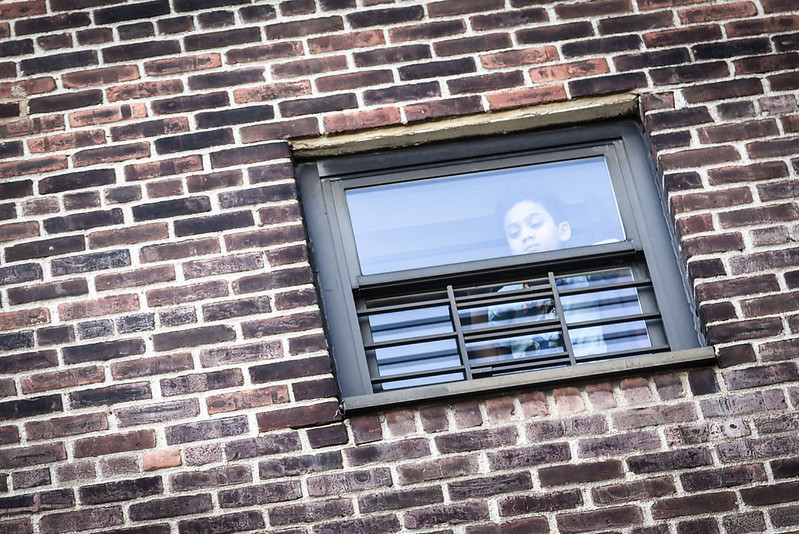
At NYCHA housing (photo: Michael Appleton/Mayor's Office)
When New York ended its moratorium on evictions a year ago, many people—from tenants to housing advocates to the public at large—braced for mass eviction filings in housing courts. One year later, tens of thousands of tenants in public housing are still waiting for the other shoe to drop.
When the federal and state governments provided funds to help tenants pay rent arrears, economically-stressed residents of the New York City Housing Authority (NYCHA) were an afterthought. Though nearly half of NYCHA households are behind on rent, to the tune of $454 million, there is still no policy or funding solution in sight.
The problem is that state law placed subsidized housing tenants (including NYCHA residents) last in line for federal funds. And with the Emergency Rental Assistance Program (ERAP) closed to new applications since January, the remaining funds will likely be gone before a single NYCHA tenant makes it to the top of the list.
Though NYCHA’s 400,000 residents have their rent capped at 30% of their income before taxes, when your income is $24,000 a year (the average income for NYCHA households), there is already little financial room to make ends meet. Add record-setting inflation to the mix, and it’s impossible for tens of thousands of tenants to pay off their arrears.
This means NYCHA tenants like Carmen, a client of the Red Hook Community Justice Center, face the real possibility of eviction. Carmen has lived in the Red Hook Houses for over 25 years. It’s where she raised her three children with her husband, who passed away in January 2021. She fell behind in rent after the death of her husband due to funeral costs and other hardships during the pandemic that were not offset by NYCHA’s rent adjustment. Carmen applied to New York State’s ERAP in July 2021, but has not yet heard back from the state about her request for help.
Virgen, another tenant in Red Hook, lives with a disability and is also experiencing the stress and fear of a potential eviction. With $10,000 due in back rent, Virgen has stretched her Social Security income during the pandemic to cover the basics like groceries, as well as medical supplies to protect herself from the virus. Her limited income also went to hiring an outside repairman to fix her kitchen sink after NYCHA workers told her that they didn’t have any cabinets left in stock. Virgen applied to ERAP in August 2021, but is losing hope after months of hearing state workers tell her that private tenants are a higher priority. She regularly calls the neighborhood’s housing court to check if NYCHA has yet filed an eviction case against her.
An eviction is a calamitous event for a family and community, impacting mental health, child development, and economic stability. Evictions also affect communities, disrupting the ties that make them resilient and safe. Through the Center for Justice Innovation’s work at our neighborhood-based housing courts, we have seen firsthand that it is impossible to address other crucial issues like employment and education without ensuring housing stability.
We cannot abandon NYCHA tenants or the buildings they call home. In the short-term, we must provide immediate relief to the nearly 50% of households who have fallen behind on rent. Far from a handout, emergency rental funds to public housing residents will not only ensure housing stability for thousands, but also give NYCHA urgently needed income to prevent the complete breakdown of its ability to fulfill its most basic obligation to provide habitable housing. As interim NYCHA CEO Lisa Bova-Hiatt has said, “Without money, we can’t do anything else. We can’t fund the much needed repairs. We can’t handle emergencies.”
The danger of inaction is substantial and disproportionately hurts women, as illustrated in Carmen and Virgen's experiences. For families evicted from NYCHA, the next stop is often the shelter system. Homelessness is associated with a wide range of harms, especially for children, not to mention the substantial cost to the city. In fiscal year 2022, New York City spent an average of $186 per day to shelter a family with children, and the average length of stay was 534 days. This means for every family evicted who ends up in shelter, the city will have to pay on average over $100,000 for temporary shelter, unequivocally more expensive than helping to keep adults and children stably housed.
The problems facing NYCHA can seem overwhelming, but helping tenants pay rent arrears is a right-sized, money-saving step that will have a direct, immediate impact. Not only will it forestall a crisis for thousands of families, but it will give NYCHA an essential infusion to prevent its problems from getting worse. If federal money isn’t coming, that means devoting city and state dollars to solving it. The health, safety, and well-being of hundreds of thousands of vulnerable New Yorkers is at stake.
***
Courtney Bryan is executive director of the Center for Justice Innovation, which runs the Red Hook Community Justice Center and its Housing Resource Center in partnership with the New York State Office of Court Administration. On Twitter @innovjustice.
***
Have an op-ed idea or submission for Gotham Gazette? Email This email address is being protected from spambots. You need JavaScript enabled to view it.
For a Just Energy Transition that Preserves Jobs, Clean Hydrogen Must Be Part of the Playbook
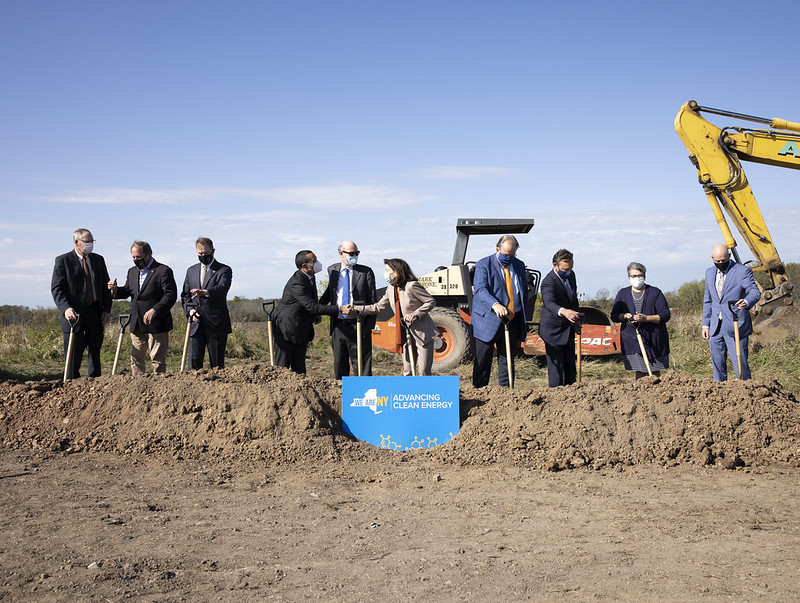
Gov. Hochul celebrates clean hydrogen (photo: Mike Groll/Governor's Office)
Too often, conversations about how to address climate change have a glaring blind spot. Supporters and opponents frequently debate the merits of various clean energy solutions and argue over where to locate wind turbines and solar fields. But one key piece of the clean energy puzzle remains conspicuously absent: the people who will build and operate clean energy facilities.
We are encouraged to see that Governor Hochul is addressing the often-overlooked issue of the clean energy workforce head on in her 2023 agenda. Her promise to establish a new "Office of a Just Transition” to ensure energy workers are not left behind is a welcome acknowledgement that building green infrastructure is going to require a massive mobilization of highly-skilled labor.
New York must continue to activate all available resources and tools to meet ambitious climate goals to maintain reliability and stimulate job growth.
The state Climate Action Council’s non-binding Scoping Plan respects this challenge by including a framework to implement access to alternative fuels such as clean hydrogen. The good news is a hydrogen blend used for power generation at a New York Power Authority plant on Long Island demonstrated decreased carbon emissions by 14% and continued reliability of thermal plant operations.
These cutting-edge research results will only get better over time and provide new data to inform New York’s comprehensive decarbonization strategy.
Clean hydrogen creates good-paying and family-sustaining jobs while lowering emissions and advancing New York’s clean energy goals. A versatile and safe fuel, hydrogen is an abundant domestic resource that supports the large-scale integration of renewables into the energy system.
According to the International Energy Agency, hydrogen can reduce carbon emissions in industry and transport by 60 gigatons, and help to store and transport renewable energy. It can also reliably deliver clean commercial and residential heat solutions and provide vital, on-demand, carbon-free fuel for power generation. Investments in hydrogen hub programs by the federal government acknowledge the anticipated role that clean hydrogen will play in decarbonizing energy footprints.
Critically, replacing existing power plants that run on fossil fuels with those that run on clean hydrogen allows us to rapidly reduce emissions without displacing workers or jeopardizing reliability. For decades, power generating facilities have supported municipalities and school districts anchored by a strong union workforce.
At a power plant, the turbine, generators, and site equipment operate the same way whether the unit is fueled with natural gas or hydrogen. Converting a fossil fuel power plant to clean hydrogen requires no more training than the adoption of any other new piece of equipment.
We can see the benefits for workers by looking at the Port Jefferson Power Plant on Long Island, which employs roughly 75 local men and women. Many of the workers at the plant have been there for three decades, establishing themselves as experts in the field. Converting the plant to clean hydrogen instead of shuttering it ensures this generation of skilled workers, some just years away from retirement, can keep their jobs and play a pivotal role in achieving New York’s greenhouse gas reduction targets.
In addition to plant conversions, energy companies also need to provide access to training and upskilling programs to prepare workers for new opportunities in the green economy. National Grid has been positioning workers to build offshore wind and solar as more renewable projects come online. The education sessions are weeks long, conducted during work hours, and paid in full by the company. At the end, employees are ready for clean energy jobs that provide the same pay and benefits they were receiving working on fossil fuel projects.
New York’s commitment to a just transition must protect the workers who have labored for years to keep our lights on and homes warm. Their know-how will allow us to accomplish a smooth transition to 100% reliable, renewable energy sources that are affordable for ratepayers.
Clean hydrogen is one of the keys to a just transition that meets state climate goals while preserving good jobs and system reliability. We look forward to working with state leaders and climate stakeholders to ensure it remains a pillar of New York’s clean energy future.
***
Will Hazelip is President of National Grid Ventures, Northeast. John Murphy is New York State Representative, United Association of Journeymen and Apprentices of the Plumbing and Pipe Fitting Industry of the United States and Canada.
***
Have an op-ed idea or submission for Gotham Gazette? Email This email address is being protected from spambots. You need JavaScript enabled to view it.
Mayor Adams’ Plan For Housing and Good Jobs Is The Right One
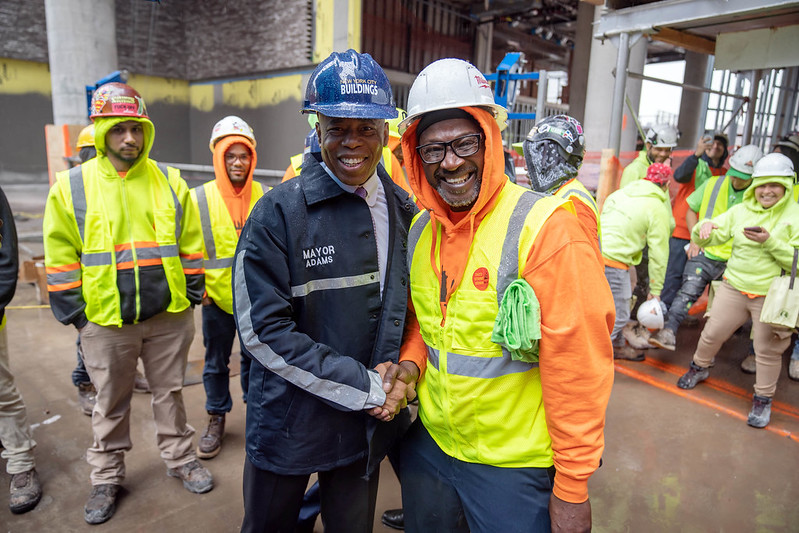
Mayor Adams talks housing (photo: Mayor's Office)
Mayor Eric Adams has set the right tone and vision for rebuilding New York City’s middle class, and the Working People’s Agenda he outlined in his State of the City address should be welcomed by all New Yorkers.
A recent Moody’s Analytics study rated New York City #1 among the most rent-burdened cities in the nation. It’s an honor none of us want. That report also said that a New Yorker needs to earn at least $177,000 annually to not be “rent burdened,” as defined by the federal government. Moody’s found that many New Yorkers need to spend an astounding 69% of their income on rent.
As Mayor Adams indicated, making New York City more affordable and accessible hinges on the construction of 500,000 more homes across all five boroughs over the next decade. He has committed $23 billion for housing, including money for repairs to NYCHA buildings. As he stated clearly:
1) “You need good jobs and pathways to get those jobs, and those jobs need to be able to support a home for you and a family,” and
2) “New York must remain a place where working people can get a foothold and afford an apartment while simultaneously raising a family in a community.”
These issues are hardly new. As far back as 1997, the New York City Council was documenting the city’s declining middle class in its report Hollow In The Middle: The Rise and Fall of NYC’s Middle Class. But with renewed leadership and vision in City Hall, we have an opportunity to finally turn these trends around.
We can accomplish these goals, in addition to the mayor’s call for increased MWBE contracting goals and connecting New Yorkers to apprenticeship programs.
First, the only way to create good jobs in construction is by hiring union contractors to meet the city’s housing needs with the 100,000 diverse workforce members they employ. Here is what the Building Trade Employers Association’s (BTEA) union construction industry looks like today:
1) More successful MWBE contractors than any other in New York, with 42% having revenues of $5 million or more and 21% having revenue of $1-5 million.
2) Over 50% of the 100,000 members of the building trade union employed by BTEA contractors are people of color — 30.5% Latino and 21.2% Black, as well as 3% women.
The New York City Economic Development Corporation’s January 2023 economic snapshot report showed there are significant disparities within the labor market in unemployment with the Black unemployment rate at 11%, which is 4 times the rate of white unemployment at 2.8%.
A 2021 study conducted by Urbanomics for the BTEA shows that Black union construction workers earn 36.1% more in wages than Black non-union construction workers. And Latino union construction workers earn 52.7% more in wages than non-union Latino workers.
The BTEA recommends the following:
- Quickly implement the Mayor’s recommendations from his Get Stuff Built report.
- Commit to building quality housing with BTEA contractors and building trade union labor.
- Reduce the cost of construction by eliminating unnecessary hurdles and red tape, like the state’s outdated Scaffolding Law that places exorbitant insurance premiums on builders, especially women and minority contractors.
- Adopt the recommendations of the Mayor’s Capital Process Reform Task Force for public works contracts.
Many of these recommendations will require state legislation and New York City needs the governor and the Legislature to work in partnership to turn these recommendations into reality. Sitting in the same room working toward a common goal, developers, contractors, building trade unions, and community leaders can achieve the mayor’s goals and make New York City affordable and livable again for families.
Let’s rebuild the middle class base that has long been the backbone of this city and make sure the slow hollowing out that has taken place over the last quarter-century is no more.
***
Louis J. Coletti is president and CEO of the Building Trades Employers’ Association (BTEA).
***
Have an op-ed idea or submission for Gotham Gazette? Email This email address is being protected from spambots. You need JavaScript enabled to view it.
The City Council Should Reject Misguided Housing Bill
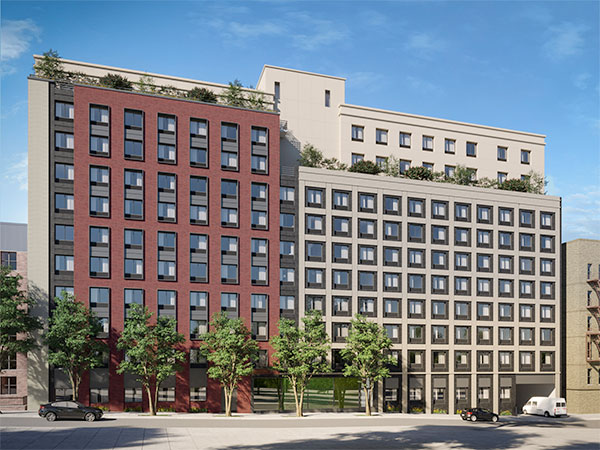
Affordable housing in the Bronx (photo: @NYCHousing)
A new consensus is taking shape in New York City: politicians, advocates, and policymakers are prioritizing ways for the city to produce more housing. Of course, there are still plenty of housing disagreements, but most now agree that New York’s severe affordability crisis is caused by the fact that there is not enough housing to go around.
While this is progress, New York City still has plenty of work to do if Thursday’s City Council Housing and Buildings Committee hearing is any indication.
City Council Members will hear feedback on a series of misguided bills highlighted by Intro 0637, which would require New York City to “prioritize not-for-profit developers and community land trusts” whenever it “disposes of land for affordable housing.” While that may sound innocuous, it would impose new bureaucracies and inefficiencies in housing production. It is the exact type of housing policy that got us into this crisis in the first place – and one that should be roundly rejected.
First, it is important to consider the overall context in which New York is making policy. The Mayor’s Management Report showed that New York City produced 45% fewer affordable homes in 2022 than it did the year prior. Despite the city’s new language about housing production, these figures are a stark reminder that rhetoric alone will not ensure our neighbors are safely housed.
The drop comes as the need continues to grow: a recent study found that New York City needs to add an additional nearly 600,000 units just to account for the lack of production over the last decade. And with the darkest days of the pandemic now years behind us, people are flocking (back) to New York City – causing intense competition for the housing stock we do have as the economy rebounds, many workers return to the office, and others want to live in the city as they work from home.
To make a dent in this crisis, New York City needs to utilize every tool at its disposal. It makes very little sense for a policymaker to reject material help from an entity solely due to its tax status – a framework the city does not use when purchasing city vehicles or any other type of good. In fact, doing so would functionally amount to trying to solve a problem that requires two hands with one hand tied behind our back.
Worse, Intro 0637 would kneecap the affordable housing industry’s growing MWBE presence. If passed in its current form, the bill would disenfranchise businesses owned by people of color and women. Right now, roughly 80% of all projects created by members of The New York Real Estate Chamber – a BIPOC-focused chamber of commerce – are affordable housing projects done in partnership with city agencies, including affordable and supportive properties like the Alabama Avenue Apartments in Queens, The Grand in the South Bronx, and Balton Commons in Harlem.
Affordable housing production is one of few bright spots for MWBEs in New York City, as nearly 84% of MWBEs “do not have access to city spending” right now and just 3.8% of city contracts flow to MWBEs. By prioritizing non-profits on City-owned land, we risk perpetuating these figures for no reason other than to satisfy pre-existing ideological preferences.
That last point is particularly instructive: there is no reason for this so-called “fix.” Because of the way affordable housing is created, all City-owned land goes through a request-for-proposals (RFP) process that guarantees permanent affordability regardless of a developer’s tax status, so the change would have zero bearing on the rents residents would pay, even decades from now.
Additionally, for-profit developers are already prohibited from bidding on such RFPs unless there is at least 25% ownership in a project by either a not-for-profit or MWBE. In other words, Intro 0637 would slow housing production by limiting choice and further closing off MWBE firms from city coffers to solve a problem that does not exist.
New Yorkers deserve housing policy conversations that will meaningfully address the housing shortage that is causing rents to balloon for everyone. What they will get on Thursday is a distraction from those core issues – and a return to a time when New York City’s leaders were far less serious about making the City as affordable as it can be.
***
Jolie Milstein is president and CEO of the New York State Association for Affordable Housing. On Twitter @NYSAFAH.
***
Have an op-ed idea or submission for Gotham Gazette? Email This email address is being protected from spambots. You need JavaScript enabled to view it.
New York Latino Politics Beyond New York City
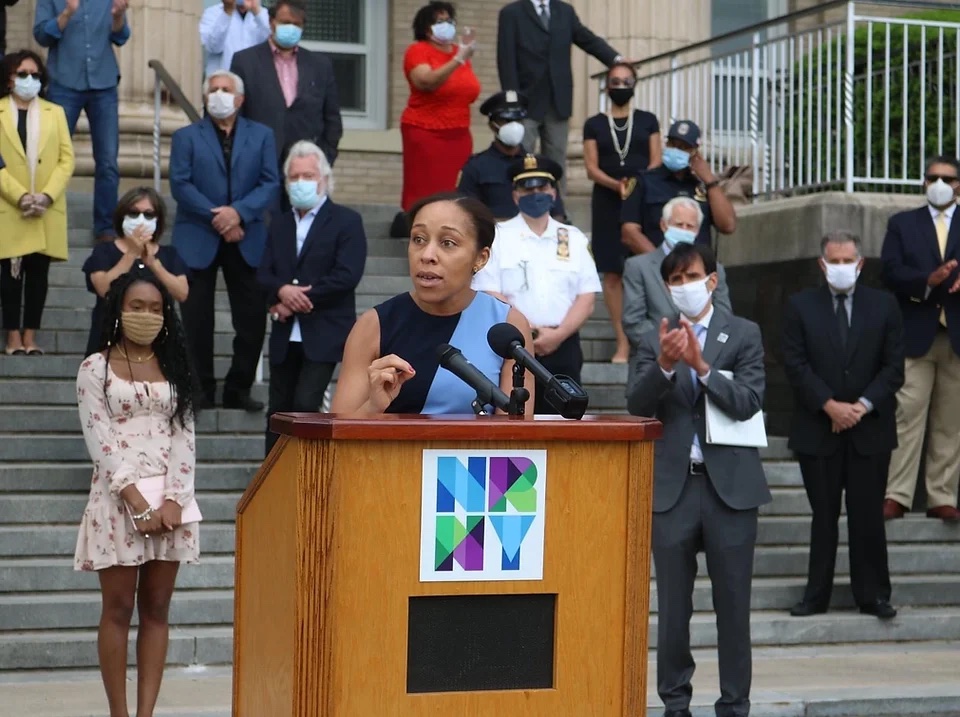
Yadira Ramos-Herbert (photo via campaign website)
On Thursday February 16, the New Rochelle City Democratic Committee made history by endorsing the mayoral candidacy of Yadira Ramos-Herbert in this year’s election. An Afro-Latina of Puerto Rican and Dominican descent and currently a City Council member, Ramos-Herbert is the first person of color to receive a major party’s endorsement for mayor in New York’s seventh largest city. Ramos-Herbert’s candidacy and the committee’s endorsement helpfully remind us that Latino politics in New York is about more than New York City; the Latino presence has been and continues to be felt throughout the Empire State.
Truth be told, my columns for Gotham Gazette have focused exclusively on the Latino political reality in New York City or at the statewide level. That’s for one key reason: because the overwhelming majority of the Latino population in New York resides in New York City — about 67%. Most Latino elected officials in New York represent parts of Gotham as well. Yet, that focus of mine (and sometimes others’) overlooks a good portion of our peoples’ political realities in other parts of the state — realities that point to growing Latino communities and their significant political achievements. It is high time I correct that oversight.
The achievements of Latinos in New Rochelle are one such example. In many ways, New Rochelle has been a city of firsts in New York. It is there where the first Mexican-born candidate was elected in New York — Roberto Lopez, elected to New Rochelle’s City Council in 2007. Along with Ramos-Herbert, the current New Rochelle City Council also includes Latina Martha Lopez.
The Latino population in New Rochelle has increased rapidly over the last few decades and Latinos now comprise a third of the population in that city. Most of those Latinos are of Mexican descent. The rise of Latinos in the overall population has also resulted in an increase in the number of Latino registered voters, who have now surpassed African Americans as the largest non-white ethnic group among registered voters, forming 20% of the overall electorate. Surely Ramos-Herbert as the mayoral pick for the New Rochelle Democratic Party reflects that the future of the city is Latino.
Yet New Rochelle is not the only city in Westchester County with a growing Latino population. The city of Yonkers, the county’s most populous, has the largest number of Latinos, according to census data, with 89,605 Latinos, a whopping 42% of its entire population. However, when it comes to the voting population, Latinos make up only 31% of the electorate. The city of Yonkers has one Latina in the City Council out of six council members, Corazon Pineda-Isaac, who has just declared her candidacy for mayor in this year’s election. Yonkers also has a Latino representative in Westchester County’s Board of Legislators — José Alvarado, who became the first Honduran to win election to a position in New York in 1982.
The Latino presence there led to the creation of the organization Hispanic Democrats of Westchester. Founded and still led by Robin Bikkal, the group has endorsed a slew of candidates up and down the county, including again supporting the candidacy of Luis Marino, who in 2021 became the first ever Latino mayor of the Village of Port Chester.
But another county not far outside of New York City has more Latinos even than Westchester — Suffolk County on Long Island. With over 332,000 people, Suffolk’s Latinos make up 22% of the overall county population, but only 11% of the voting population. Its legislature has two Latinos out of 18 total seats— Sam Gonzalez and Manuel Esteban. This represents just 11% of that legislative body. Suffolk County also sent the first Long Island Latino to the State Legislature: since 2002, Assembly Member Phil Ramos has represented Central Islip in the Assembly, and is now that body’s deputy speaker. Suffolk has also sent to the State Senate Monica Martinez, a Latina who previously served in Suffolk’s legislature. Her brother, Antonio Martinez, is a Councilman in the town of Babylon.
Next door, Nassau is the county with the third largest Latino population outside of New York City. Latinos now make up 18% of the overall population and 11% of the voting population. And yet the Nassau County legislature currently has no Latino representation.
Further north, the cities of Buffalo and Rochester also have a Latino presence. Buffalo currently has a Latino representative in the State Assembly with Jonathan Rivera, and David Rivera is the majority leader of Buffalo’s Common Council. Rochester’s City Council president is Latino, Miguel Melendez. Joining him on the Council is another Latino, José Peo.
According to the National Association of Latino Elected and Appointed Officials’ last published data on New York’s Latino political representation, there are 157 elected and appointed Latino officials in New York, outside of those elected to Congress and the State Legislature.
In short, Latino presence in political leadership is increasingly felt all over the Empire State. Yadira Ramos-Herbert’s candidacy for mayor of New Rochelle is only the latest example of Latinos rising toward higher office.
***
Eli Valentin is a political analyst and author of the forthcoming book, Reinhold Niebuhr: A Political Life. On Twitter @EliValentinNY.
***
Have an op-ed idea or submission for Gotham Gazette? Email This email address is being protected from spambots. You need JavaScript enabled to view it.




